A meadow in a vase
August 21st, 2010
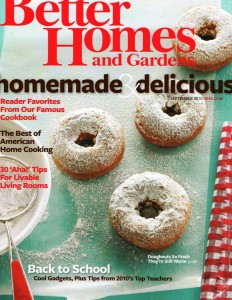 The September issue of Better Homes & Gardens features my “Debra’s Garden” column encouraging readers to add ornamental grasses to their seasonal flower arrangements.
The September issue of Better Homes & Gardens features my “Debra’s Garden” column encouraging readers to add ornamental grasses to their seasonal flower arrangements.
The photo that accompanies the piece depicts a gorgeous autumn bouquet bursting with asters, fall foliage and miscanthus blades.
Its sultry palette includes dark purple, russet-red, gold and green elements in a clear, glass vase. As a footnote, I promised to show off my favorite grasses for cutting and flower arranging here on this blog.
As it turns out, I’ve been seeing a lot of wonderful ornamental grasses and grass-like design ingredients lately. These days, I have dreamy plumes of fountain, feather, and silver grasses on my mind.
There’s something both completely romantic and purely modern about grasses in floral arrangements (or in the landscape, for that matter). Here’s a peek at what’s caught my eye this year, including my favorite grasses for cutting:
FROM THE FLOWER FARM
Owned by Diane Szukovathy and Dennis Westphall, Jello Mold Farm is one of my favorite local flower sources here in the Pacific Northwest. Diane and Dennis use sustainable practices and recently they’ve delighted floral design customers with gorgeous late-summer grasses. You can find Jello Mold Farm at the Queen Anne Farmers’ Market every Thursday – be sure to check out the incredible selection of downy and fluid grasses.
Here are a few show-stoppers included on Diane’s “fresh list” that she emails to customers every Monday. The four images you see here were taken by Diane:
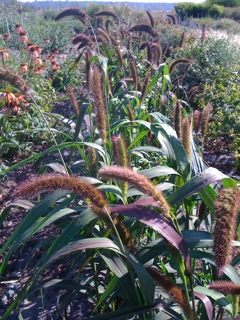
Jello Mold's RED JEWEL MILLET, with large, elegant, arching, red-toned seed-heads approximately 5 inches long
These awesome examples are ornamental millets, not edible ones.
While actually cultivars of Pennisetum glaucum, you can almost convince yourself that they are relatives of the corn family if you squint.
When cut for bouquets, the plants yield both the sweet, furry seed-heads, as well as the strapping, wide leaf blades. Both plant elements are useful in an arrangement as beautiful counterpoints to blooms.
Like many good things, “more is better.” For example, I like to gather several seed-heads together in a clump and inset them into the arrangement.
It’s a pretty picture to have three to five seed-heads cascading out of a bountiful grouping of seasonal flowers and foliage. MORE COOL GRASSES

Jello Mold's PANICUM VIOLACEUM GRASS--elegantly draped tassels, green with darker tips on seedheads and foliage; 36-inch stems.
GRASSES IN VASES
I recently had the chance to get creative with Jello Mold Farm’s fresh-from-the-field ingredients – and you can be sure I incorporated grasses into the designs.
Conjured up at Ravenna Gardens, where owner Gillian Mathews and I are planning our first in-store floral design workshop (details to come, but save the date for September 29th), these arrangements showcase the palette and textures of late summer and early autumn.
Here are two:
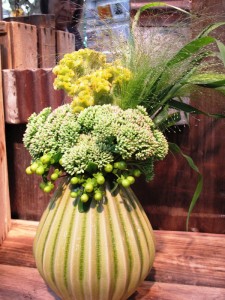
My design uses great ingredients grown by Jello Mold, including young sedum, green hypericum berries, lemon-lime celosia, and a spray of FROSTED EXPLOSION GRASS. Diane says the green seed heads look like fiber optics with darker tips.
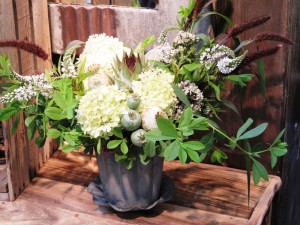
Another bouquet I designed using Jello Mold's wonderful array of ingredients includes creamy while hydrangeas, baptisia foliage, gooseneck loosestrife and the RED JEWEL MILLET seedheads.
If you’re inspired to grow more ornamental grasses in the garden – both to appreciate how they mingle with other plants, as well as how they shine in your bouquets – you’re in luck. There’s a meadow filled with grasses waiting for you!
I was in Chicago last week for several days to speak at the Independent Garden Center Show. In addition to giving two presentations, I spent mucho time working the aisles of the enormous trade show floor.
Who could have imagined so many plants, products, remedies, accessories, ornamental objects, furniture, containers, garden gloves, tools and seeds in one place?
I’ll write more about the trade show next week, but let’s start with Chicago’s botanical showpiece at The Lurie Garden.
I felt fortunate for the opportunity to take in an early-morning tour of Chicago’s Millennium Park with fellow writers. While there, we studied the planting schemes of Dutch wizard Piet Oudolf at The Lurie Garden, a central element of the public space.
Here is a little info about this awesome, thoroughly metropolitan setting:
The five-acre urban greenspace was completed in 2004. Essentially a rooftop garden, Millennium Park and The Lurie Garden are situated over a network of underground parking garages, presenting special but manageable plant care challenges that home gardeners will recognize and appreciate. While the Lurie Garden is an urban model of responsible horticulture, the emphasis on sustainability also brings practical rewards: the long-life and hardiness of the garden’s plants help ensure that maintenance does not become too costly.
GRASSES IN THE LANDSCAPE
Mary Ann Newcomer (Gardens of the Wild, Wild West) led the way, with Susan Appleget Hurst (Cake in the Garden) and me willingly jumping into the back of a taxi cab to take the short ride to the park.
The time of day: 7:30 a.m.
The weather: a perfect summer moment when the sun was still hiding behind the clouds making our cameras happy.
The place: a nearly-empty (of people) garden of delightful plant combinations.
More on The Lurie Garden:
The Lurie Garden in Millennium Park is an urban oasis emerging from a harmonious blend of symbolism, landscape design and ecological sensitivity. Its design pays homage to Chicago’s transformation from flat marshland to innovative green city, or “Urbs in Horto” (City in a Garden).
Visitors find respite and inspiration in four seasons. In early spring, sun-hungry bulbs and perennials stretch through soil and begin anew. Summer and fall teem with the flutter of butterflies and birds. Winter’s seed heads and ornamental grasses capture snow and ice, creating graceful art forms.
The Lurie Garden is living art – a palette of texture and color blending Chicago’s unique culture, ecology, history and people.
Highlights of the garden include the dramatically lit, 15-foot-high “shoulder” hedge. This physical representation of Carl Sandburg’s famous description of the “City of Big Shoulders” encloses the garden on two sides and protects the delicate perennial garden.
A graceful hardwood footbridge over shallow water divides the garden diagonally between “light” and “dark” plates.
Here are some of the amazing ornamental grasses we saw in this landscape. Each is an excellent choice for the residential landscape as well as the autumn cutting garden:
- Deschampsia caespitosa ‘Goldstaub’
- Molina caerulea ‘Dauerstrahl’
- Molina caerulea ‘Moorflamme’
- Schizachyrium scoparium ‘The Blues’
- Chasmanthium latifolium
- Molina caerulea ‘Dauerstrahl’
- Molina litoralis ‘Transparent’
- Pennisetum alopecuroides ‘Cassian’
- A sweet pennisetum.










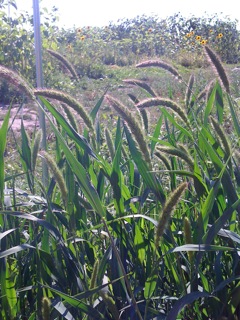



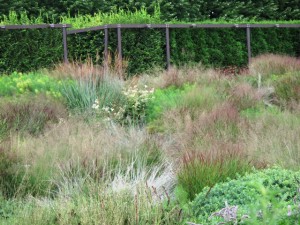
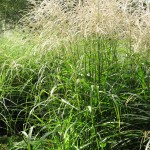

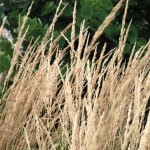
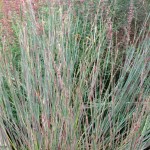
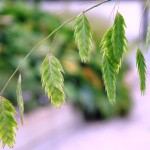
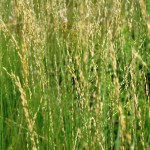
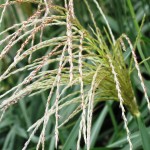
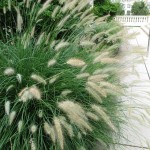
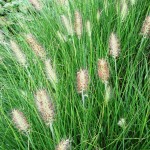
August 24th, 2010 at 12:08 pm
Enjoyed your blog on using grasses in vases. I tried to do this and after a few days, the seeds from the plume were all over the floor. Are there some grasses that will hold their seeds longer then others. Can I treat them with something like hairspray etc. I used some of the Cabaret grass.
August 24th, 2010 at 1:37 pm
I see so many wonderful grasses on the roadsides this time of year here in the south. Your post reminded me to incorporate them into my floral designs. they certainly give it a regional flair!
.-= compostinmyshoe´s last blog ..She Scares Me =-.